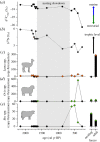A 2200-year record of Andean Condor diet and nest site usage reflects natural and anthropogenic stressors
- PMID: 37132237
- PMCID: PMC10154929
- DOI: 10.1098/rspb.2023.0106
A 2200-year record of Andean Condor diet and nest site usage reflects natural and anthropogenic stressors
Abstract
Understanding how animals respond to large-scale environmental changes is difficult to achieve because monitoring data are rarely available for more than the past few decades, if at all. Here, we demonstrate how a variety of palaeoecological proxies (e.g. isotopes, geochemistry and DNA) from an Andean Condor (Vultur gryphus) guano deposit from Argentina can be used to explore breeding site fidelity and the impacts of environmental changes on avian behaviour. We found that condors used the nesting site since at least approximately 2200 years ago, with an approximately 1000-year nesting frequency slowdown from ca 1650 to 650 years before the present (yr BP). We provide evidence that the nesting slowdown coincided with a period of increased volcanic activity in the nearby Southern Volcanic Zone, which resulted in decreased availability of carrion and deterred scavenging birds. After returning to the nest site ca 650 yr BP, condor diet shifted from the carrion of native species and beached marine animals to the carrion of livestock (e.g. sheep and cattle) and exotic herbivores (e.g. red deer and European hare) introduced by European settlers. Currently, Andean Condors have elevated lead concentrations in their guano compared to the past, which is associated with human persecution linked to the shift in diet.
Keywords: birds; condor; diet; nest; palaeoecology; volcano.
Conflict of interest statement
The authors declare there are no competing interests.
Figures






References
-
- Witmer GW. 2005. Wildlife population monitoring: some practical considerations. Wildl. Res. 32, 259-263. (10.1071/WR04003) - DOI
-
- Duda MP, Hargan KE, Michelutti N, Blais JM, Grooms C, Gilchrist HG, Mallory ML, Robertson GJ, Smol JP. 2021. Reconstructing long-term changes in avian populations using lake sediments: opening a window onto the past. Front. Ecol. Evol. 9, 698175. (10.3389/fevo.2021.698175) - DOI
-
- Selbie DT, Lewis BA, Smol JP, Finney BP. 2007. Long-term population dynamics of the endangered Snake River Sockeye Salmon: evidence of past influences on stock decline and impediments to recovery. Trans. Am. Fish Soc. 136, 800-821. (10.1577/T06-100.1) - DOI
Publication types
MeSH terms
LinkOut - more resources
Full Text Sources
Miscellaneous

